The Group Medal (De Groepsmedaille)
Qualification
Awarded to each registered group who successfully completes all four days of the March.
Registered groups must consist of at least 11 members (a leader and 10 other walkers). They are required to start together each morning and be together at checkpoints and the finish. Originally, all had to complete the marches for the group to receive the award. Since 1973 a group can qualify if no more than 10% of walkers retire during the march. This 10% is rounded up. For example if a team has 13 participants at the start, 10% equates to 1.3, and up to two group members can withdraw and the group medal still be awarded.
Both civilian groups and military detachments qualify, one medal per group. The Group Medal is awarded in addition to the Vierdaagse cross that is awarded to each individual group member.
Early awards
The Group Medal was being awarded as early as 1913 to military detachments and was known as the 'korpsprijs'. Civilian groups were first allowed to register for the Vierdaagse in 1923. They became eligible for the Group Medal on the same terms as military groups, civilian groups out-numbering military ones by the early 1930's.
In 1928 four groups from Great Britain took part for the first time. The four Group Medals they earned were mounted on what was titled the ‘Nijmegen Shield’. This is still awarded as a trophy for the British National 20 km race walking Championship organised by the British Race Walking Association.
As well as the Vierdaagse at Nijmegen, the Group Medal was also awarded to groups who took part in the four day marches organised in various locations in the Dutch East Indies between 1936 and 1939.
The medal is sometimes seen with the name of the military unit or walking club engraved on the reverse along with the year of award. Two examples are shown in the pictures below.
The Medal
There have been a number of changes over the years, with six main variants. Those bearing the Queen's head (awarded until the late 1970's) have a diameter of 53 mm. The current version (awarded since circa 1980) has a diameter of 50mm. Until 1976 all were manufactured by Koninklijke Begeer, those awarded since 1977 by W. van Veluw.
The portrait of Wilhelmina dates from 1900, when the Queen was nineteen years of age. As an example, the identical obverse was used on a medallion made by Begeer to commemorate the Queen's visit to Utrecht in July 1900.
The period of award, indicated below, for each of the three Wilhelmina types is based on examples seen with the year and group name engraved on the reverse.
.jpg)
.jpg)
Wilhelmina. Up to circa 1930. In ungilded bronze, with a top ring. This example has BRONS stamped on the edge. It was awarded without a ribbon and was not designed to be worn. Earlier versions were awarded with a suitable inscription on the reverse side. On the example below, 'Afstandsmarschen Korpsprijs' translates as 'unit award for distance marches'.
Wilhelmina. Circa 1930 – 1950. There is no top ring. This type may have been introduced in the late 1920's, with the earlier ringed type awarded alongside it in order to use up old stock.
Awarded in both gilded and ungilded bronze.
Ungilded bronze, awarded pre-war, up to the 1939 March:
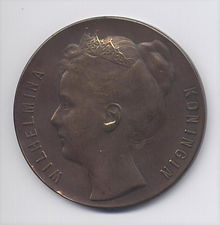.jpg)
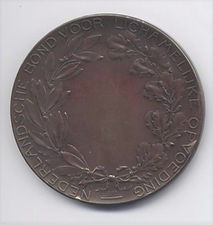.jpg)
Gilded bronze, seen for awards made post war, 1946 and after:
.jpg)
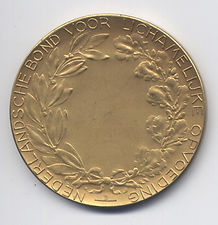.jpg)
Juliana (NBVLO). 1951 – 1958. Bronze gilt, often with BRONS stamped on the edge. The portrait on the obverse was adopted after Wilhelmina abdicated in favour of her daughter in September 1948 due to ill health. With the need to design and produce the new medals, and to use up existing stock, they were not introduced until the 1951 march. Examples with a top ring suspension have been seen, but are not common. The named medal was awarded in 1957 to the 1st detachment of the Centrum Opleiding Administratief Kader (Central Training Administrative Unit), Royal Dutch Army, based in Middelburg in Zeeland.
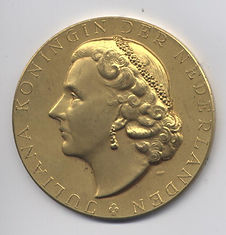.jpg)
.jpg)
.jpg)
Juliana (KNBLO). 1959 – late 1970's. Bronze gilt and a fraction thinner than before. The obverse remained unchanged, the reverse now includes the word 'Koninklijke' to reflect the royal title bestowed on the NBVLO in 1958. Examples with a top ring suspension have been seen, but are not common.
.jpg)
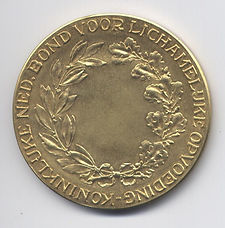.jpg)
Juliana (KNBLO). A variant of the above, noting the date '1951' to the right of the bust of Wilhelmina - the year the portrait was executed.
The medal has the same dimensions and is bronze gilt or bronze coloured metal.
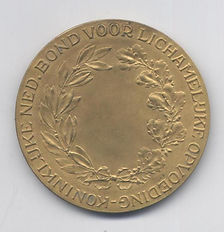.jpg)
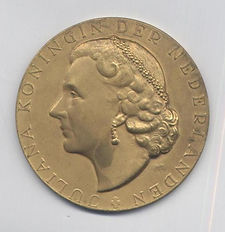
.png)
With cross on obverse. Circa 1980 to date. Gold coloured metal and thinner than earlier versions. This design was adopted after Veluw commenced manufacture of all Vierdaagse awards in 1977. Initially, existing Koninklijke Begeer stock continued to be awarded. When Beatrix became Queen in April 1980 she decided that her portrait should not appear on the medal, and the picture of the march cross was adopted.
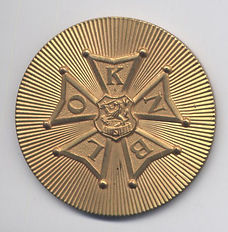.jpg)
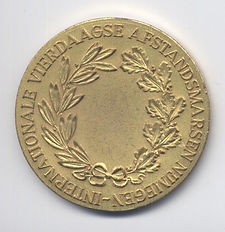.jpg)
Queen Juliana award. This medallion, apparently dating from the early 1960s, may be a group medal awarded to teams of young people, including army recruits, who completed the marches.
It is a bronze, with a diameter of 50 mm and bears the head of an older Queen Juliana on the obverse. It has no provision for a ribbon and was not intended to be worn. It was awarded in a white card box bearing the name of the manufacturer - Koninklijke Begeer.
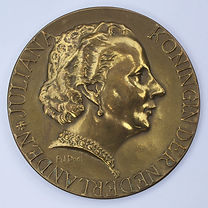
.jpg)

